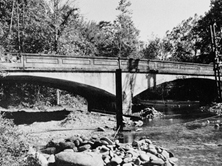 The no longer extant three-span Oconaluftee Bridge over Oconaluftee River, Cherokee, Swain County: constructed by Luten Bridge Company in 1921 (source: Library of Congress, Prints & Photographs Division, HAER, Reproduction number HAER NC-40-2)
The no longer extant three-span Oconaluftee Bridge over Oconaluftee River, Cherokee, Swain County: constructed by Luten Bridge Company in 1921 (source: Library of Congress, Prints & Photographs Division, HAER, Reproduction number HAER NC-40-2) The arch bridge dates to ancient times, with perhaps its most familiar application the stone arch aqueducts of the Romans.
In a traditional stone arch bridge, the sheer mass of material is used to absorb the stresses. Reinforced concrete arches use steel bars rather than mass to accommodate some of the stresses and cut down on the amount of material required. The reinforcing bars usually follow the shape of the arch ring on both the top (intrados) and bottom (extrados) surfaces of the arch.
During the early period of reinforced concrete arch technology, a trial-and-error approach prevailed with a variety of competing ideas about the appropriate shape, volume, and placement of reinforcing metal, but most of these questions had been worked out by engineers by 1910.
The oldest surviving reinforced concrete highway bridge in the inventory is the Caswell Branch Bridge (Craven County Bridge 187) near New Bern. The bridge was built in 1909, but the reinforcing system is unknown since there are no plans.
It is assumed that the bridge was patterned by county engineer A. Dallam O'Brien after information found in engineering literature and "how-to" pamphlets. In the era before the State Highway Department, such promotional literature did much to spread information about the advantages of reinforced concrete to county and municipal road officials.
North Carolina's Historic Bridge Inventory includes approximately 40 reinforced concrete arch bridges dating from 1909 to 1960.